People
‘We’re Partners, But We’re Also Best Friends’: Painter Tschabalala Self and Curator Mike Mosby on the Rewards of Artistic Love
In Artnet News's Portraits of Love series, young creative couples offer insights into their partnerships.
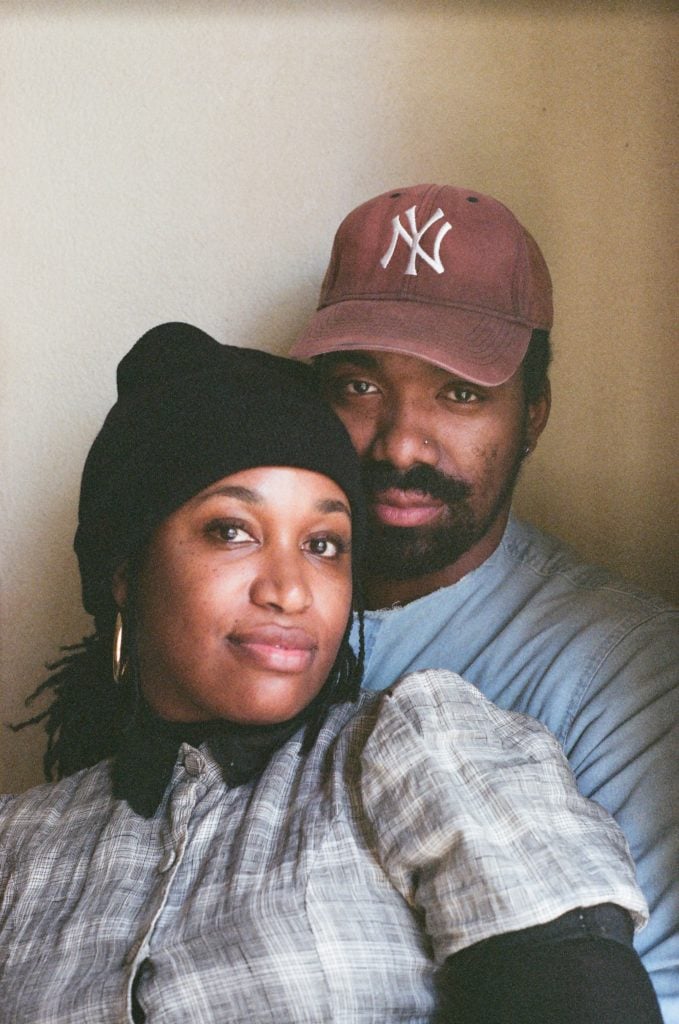
In Artnet News's Portraits of Love series, young creative couples offer insights into their partnerships.

Noor Brara

Historically, the lore of romantic relationships between famous artists has long been marked by infamy, jealousy and, more often than not, the interference of a third person. There’s Cristina Kahlo, who briefly romanced Diego Rivera and drove her sister, Frida, a little mad in so doing; Dorothea Tanning, who lured Max Ernst away from Peggy Guggenheim after a single game of chess; and Françoise Gilot, Pablo Picasso’s ultimate obsession and muse, who brought an end to his habit of trading one lover for another by eventually walking out on him. And should we be surprised? Governed by passion in their profession, it’s no wonder that artists, encouraged to explore human desire in their work, allow that fiery energy to spill over into their personal lives.
For a new series, “Portraits of Love,” Artnet News decided to learn about how present day, very-much-in-love art world couples navigate their relationships in a healthy way. Last week, we sat down with artist Tschabalala Self—a young art star whose market has exploded since she graduated from Yale in 2015—and her boyfriend, Mike Mosby (an art therapist, independent curator, and DJ) to learn about how they navigate their partnership as two creative souls in love.
Below, in their first joint interview to date, Self and Mosby share what it’s like to date your best friend, how they cultivate balance in their relationship, and how they support each other through it all.
Tell me a little about your backgrounds and how you decided to pursue your interest in the arts.
Tschabalala: I grew up in Harlem, New York. I always had an interest in art, and then I studied studio art in college and painting in grad school [at Yale]. After leaving grad school, I started pursuing it more professionally. It’s something that I’ve always had an interest in and, through school and work, I’ve been able to turn that interest into something greater.
Mike: I became interested in creative fields through my family—I grew up in a very fashionable and creative household, between my grandmother and my mother. My mother was a model when she was a teenager in Manhattan. I loved freehand-drawing on cereal boxes as a child, and I got into art films as a teen. My family moved to upstate New York from the city. Up there, I was pretty much surrounded by artists, which was pretty powerful.
So you’re both New Yorkers.
Tschabalala: Yeah. We both have family in Harlem. I went to Bard for college, and I hadn’t really gone back up there until we started dating, maybe 10 years—actually, no, not 10 years, I’m not that old [laughs]—I guess six years after I graduated.
And did you like Bard?
Tschabalala: I did. I didn’t really like the area at the time, though. I didn’t really appreciate it until I got older.
Did you both know that you wanted to pursue art professionally from a young age?
Mike: Actually, I was a pretty serious athlete growing up. I played football for 12 years of my life. I got badly injured in high school, though, and tore two ligaments in my ankle, so that sort of stopped my football career. But I still had art at the back of my mind—it was always with me. It was my Plan B in that sense, and I started to get into it more seriously. I got a job doing art therapy, working with autistic kids and adults, teaching them to express themselves and communicate through art, particularly when there’s a lack of language skills. The arts are very calming, centering, and therapeutic for the individuals I work with.
Tschabalala: I guess when I was younger I considered doing other things, but I never really applied myself that seriously to anything other than the arts. I’ve always focused on it. I don’t really know what else I could have done. I think if I wasn’t an artist, I would definitely be doing something else that’s trade-oriented…something maybe in design, or even—
Mike: Medicine?
Tschabalala: I mean, I did say that I would love to be a plastic surgeon. Also, because I’m a hypochondriac, I sometimes wish I had gone to medical school. But yeah, maybe something trade-oriented where I could work with my hands and interact with a lot of people. I do enjoy that a lot about art—that it’s public-facing.
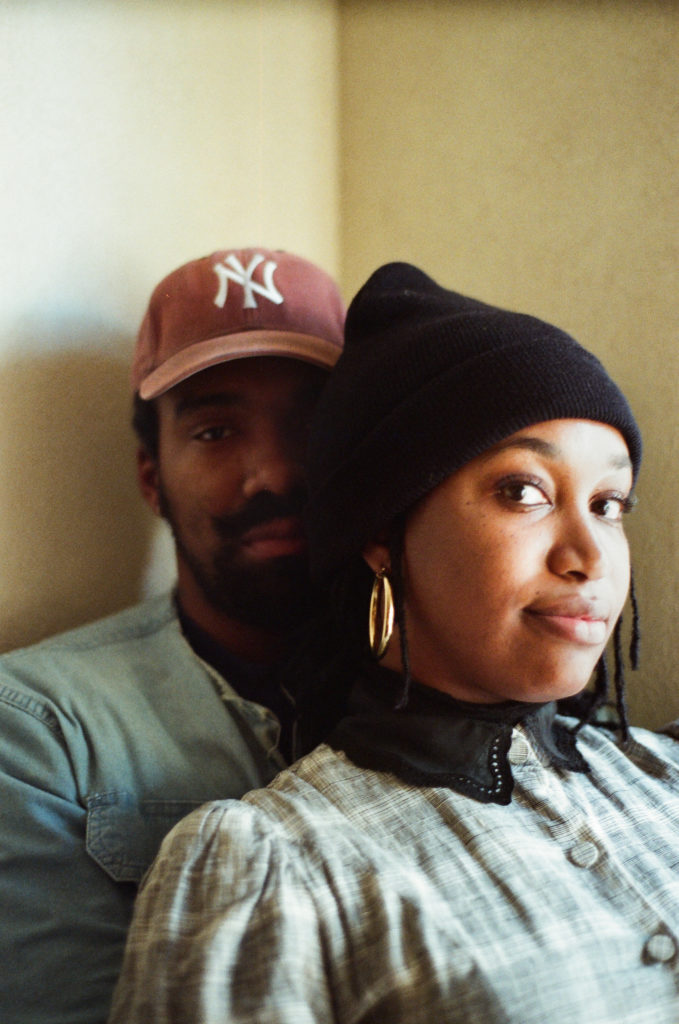
Self and Mosby. Photo courtesy Araba Ankuma.
Were there any artists—fine artists, actors, musicians or anyone in a creative industry, really—who influenced you significantly growing up?
Mike: I would have to say Denzel Washington, first and foremost. He can play any role, he’s a very versatile actor. He can play a doctor or gangster cop or a radical activist. And he’s a New Yorker, which is the icing on the cake.
Tschabalala: Oh, he is? I didn’t know that.
Mike: Yeah, he’s from Mount Vernon. And he was very involved in the Boys & Girls Clubs programs.
Also a guy named Reggie Madison. He’s an older gentleman that I grew up knowing while living upstate in Hudson. He’s a sculptor and he paints. He also incorporates a lot of jazz in his artwork—he can hear a Miles Davis or Sun Ra track, and he’ll paint or sculpt something around it. He blends music and art together.
Tschabalala: I would say a significant influence for me growing up was a woman I used to work for named Montgomery Harris. She had a boutique in Harlem called Montgomery that housed all her own bespoke designs. I worked for her pretty much every summer in high school. I really admired her because she had opened her business on her own, as a black woman creative, and she’d brought something so interesting and unique to the neighborhood. It was amazing to see what she was doing on an entrepreneurial and artistic level; it was just such a brave thing to do. So for me to see that model at that time, and to work for her, was really motivating. I got to see what it was like to live the life of a creative…all the glory of it and all the hard parts, too. She was a huge influence, and she taught me so much about fashion, art, and design. She’s still a very close friend of mine.
Is there a piece of advice that she gave you that you’ve held onto over the years?
Tschabalala: I can’t say that it was just one piece of advice, but just how she moved in the world and how she carried herself through the trials and tribulations. I took a lot from that.
And Mike, was there anything that your mentors imparted to you that’s stayed with you?
Mike: Definitely. Back to Reggie, he sort of always told me, “Be free with your mind.” And to do what makes you happy as far as art goes. He collects all these found objects—old books, old pieces of furniture—and builds these beautiful art objects and pieces. And he’d just tell me to keep pursuing what I wanted to pursue, and to be inspired by my surroundings. He’s like over 70 years old—it’s not about the money for him, it’s about having a say in the art world and the world in general. About having a voice.
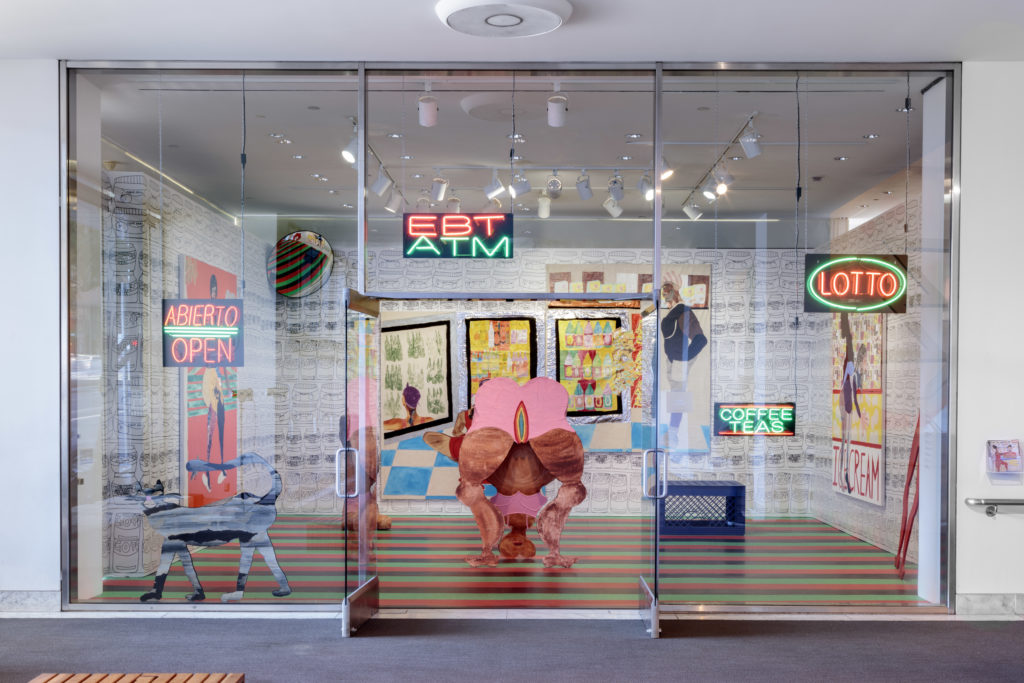
Tschabalala Self, “Bodega Run” installation view at the Hammer Museum (2019). Photo courtesy Joshua White.
How did you two meet?
Tschabalala: Through mutual friends.
Mike: At an art show! Again, in part because of my mentor and my good friend, Reggie Madison. It was the last day of Kerry James Marshall’s “Mastery” show at the Met. So on that day, I was on social media, but—to backtrack, I’d been following Tschaba’s work for a few years from her show at the Studio Museum in Harlem. She was in a group show there with some people that I knew. So, fast forward to the day. I DM’d her. I sent her a message and I was like, “Oh hey, there’s a guy having a show in Harlem named Derek Fordjour.”
Tschabalala: It was a group show, but I can’t remember who else was in the show.
Mike: But it was definitely Derek, and I was like, “I’m coming up.” That was overwhelming, the “Mastry” show, by the way. After seeing that, you can’t see anymore art, you sort of need time to really digest what you’ve seen. But I said, “You know what, I’m intrigued.” So I went up there [to the group show in Harlem], and I saw her outside and I was like, “Wow, who is this beautiful lady? This is her?!” And Reggie’s like, “Oh man, she’s beautiful.” And then we had a conversation for the whole time at the show, while we were looking at the art. We just connected. And we had mutual friends, too, and a lot of things in common, so it sort of felt like dotting the i’s, in that sense.
Tschabalala: It was sort of the perfect place to have a first date, because all my friends were there for the show.
Mike: It was a very comfortable setting in that way.
Tschabalala: And I think we all went out afterwards to Corner Social. And then I left for four weeks after that for a residency.
Mike: In Detroit!
Tschabalala: So we didn’t see each other for another month, but we talked every day.
Mike: We did the phone thing.
Phone calls or FaceTime?
Tschabalala: We did calls.
Mike: I had a flip phone, remember? iPhones are very distracting and, yeah, it would have been nice to see each other, but that would have changed the whole energy. You’re not really here you know?
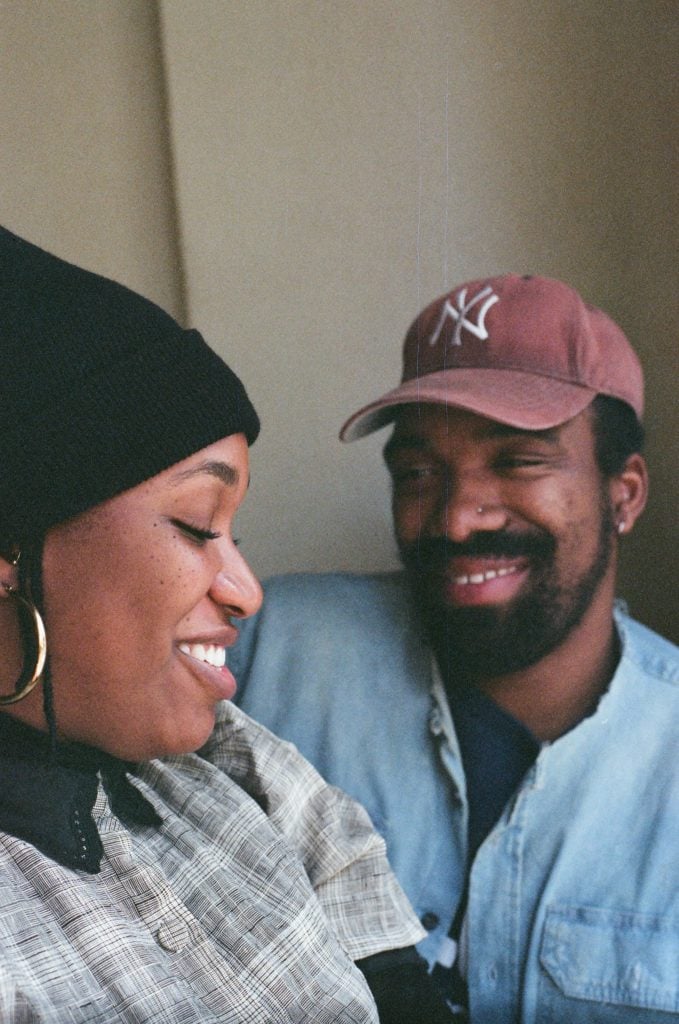
Self and Mosby. Photo courtesy Araba Ankuma.
Totally. Did you go out to visit her at all when she was over there?
Mike: No, because she was working pretty much all the time.
Tschabalala: Yeah, and my family’s out there. My aunts and my cousins live there—so I was catching up with them.
Mike: But then when she came back to New York, we just connected.
How long have you been together now?
Tschabalala: I know we first spoke on the day of the [Trump] inauguration…so as long as that.
Oh, god. No way.
Mike: I had to support her that day. So we’re going on three years!
A historic day for many reasons, in that case. How would you describe the nature of your relationship in a couple of words?
Mike: Very vibrant. Fun. A lot of teachable moments. Very spontaneous at times, but in a good way. You know every couple says, “We’re friends.” But I could really say this is my friend. We do all the things that friends do together. We go on a lot of journeys together, we have a lot of good times. There’s no pressure, no one’s really getting dragged into things they don’t want to do. Everything is mutual, so we do a lot together.
Tschabalala: I feel like I can’t beat that [description]. I would say that Mike feels very familiar and he reminds me of all the best parts of my life before I met him. I can carry all the best things with me moving forward because of him.
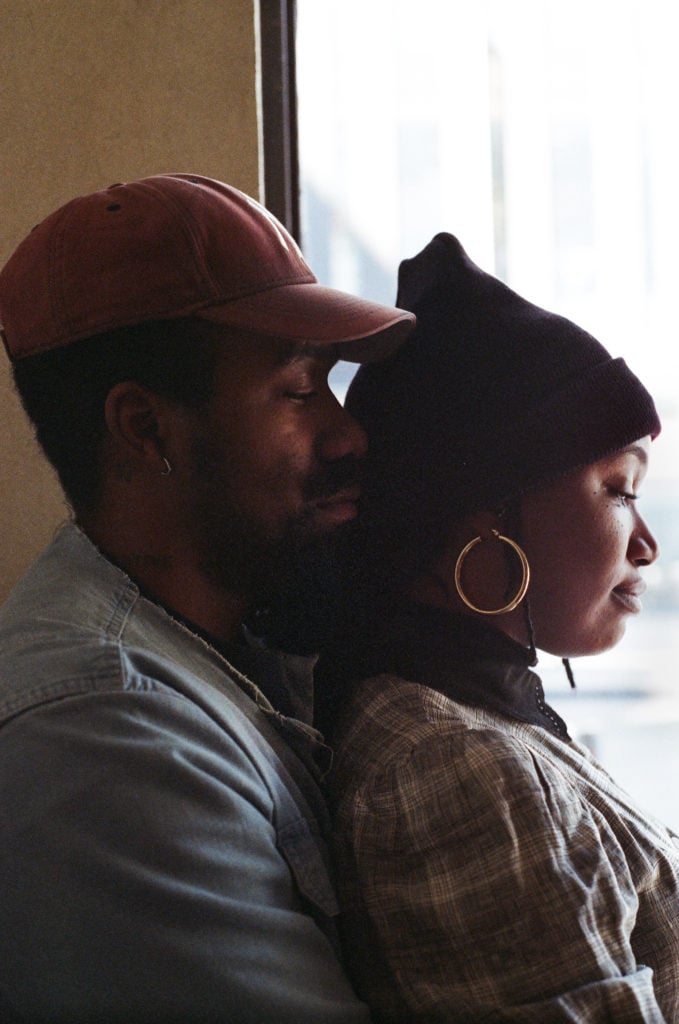
Mike Mosby and Tschabalala Self. Photo courtesy Araba Ankuma.
Sort of like your anchor, in a way.
Tschabalala: Yeah, but he encompasses all the best qualities of all my loved ones. He has all their best traits.
Mike: And she also has all the best qualities of the women in my life, my grandmother and my mother. She’s very driven—I tell her that she’s the hardest working woman I know, alongside my grandmother and my mother. This woman right here, she’s literally a workaholic, but she makes it look fun. And once you get into that world, you understand how hard it is. People have no idea. It’s seriously a ton of work. And outside of the art world, your personal life is your own life. It can be very complicated.
How have you managed to support one another through such a momentous time in both of your lives?
Mike: Communication. Just listening and trying to understand. And patience—you’ve got to have patience, too, especially for a relationship like this. You’ve got to understand the person and who you’re with. You have to give them space and time, you can’t be too clingy. You’ve got to let that person be who they’ve got to be.
Tschabalala: I would agree, it’s a balance between working on building a life together, but also making sure you’re working on your individual identity at the same so that you can be fully present in your relationship.
Is it ever hard to navigate the slipping on and off of those identities, those hats, as a creative and as a significant other?
Mike: I think it’s very easy for me. I don’t think I’ve ever really struggled with that. And we’ve also collaborated on a few things together.
Tschabalala: Yeah, I feel like you don’t have to take that hat off. We like to keep it on. But also relationships get really complicated, so you have to figure out ways to problem-solve creatively. But yeah, I don’t think you ever really have to take that creative hat off. I guess it’s good to always be open-minded about what’s possible.
Mike: I guess some people are afraid of compromise, but it’s really just about being understanding. You can keep your creative hat on at the same time and navigate life together. Of course you want to have your own identity and your own thoughts; you don’t want to blur everything together. But if you have an idea, you can share those ideas together.
Tschabalala: And I think that creatives understand that—even within their relationships to their work, there’s sacrifice and compromise, there’s some push and pull. If you apply that same logic to your relationship—and allow there to be some imperfection—I think that makes things simpler. I think that’s how I relate to my practice, and my relationships to my other loved ones as well. I think you have to allow for things to sometimes be nonsensical.
Mike: Perfection…I mean, come on, there’s gotta be flaws there. What’s the fun in perfection?
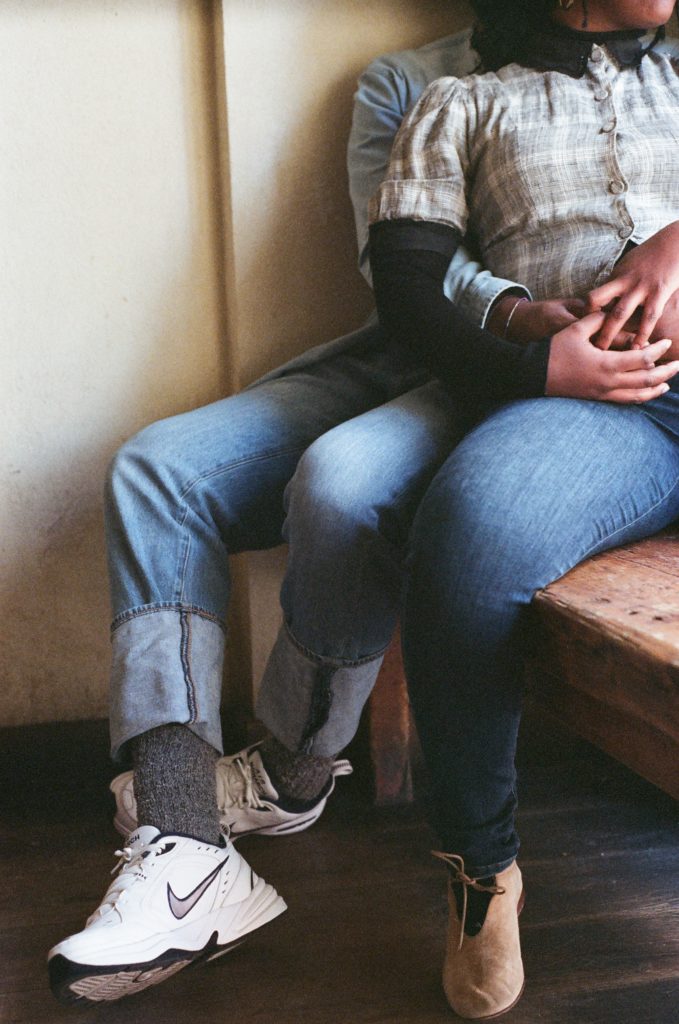
Self and Mosby. Photo courtesy Araba Ankuma.
Walk me through what it’s like for you to collaborate on a project. How do you come up with an idea and then how do you see it through?
Tschabalala: A lot of times when we’re working on something together, Mike comes up with the idea and I figure out how to actualize it.
Mike: Yeah, Tschaba’s definitely…she’s the one to sort of bring it to life. What’s an idea without any real substance? You need the action behind it, to make it something you can see.
Tschabalala: And the only thing we’ve actualized so far, really, has been our party series, Free Range. And it was really Mike’s idea to do something like that in Hudson, and then I worked to build up the infrastructure for it, and we also had one other collaborator, our friend Shaneika, who helped to form the concept. She’s a writer and a curator, so she helped to establish the vibe and mood. It was cool.
Mike: Yeah, I mean we all have our own ideas, so of course sometimes there’s friction. It happens, but we support one another. Tschaba’s been very supportive in my new venture. I’m embarking on a curatorial project, a four-person show in Hudson opening in October this year. It will be at a beautiful space—a great place to explore yourself and art. So that’s very exciting.
That’s great. Could you guys ever see yourselves living up there in Hudson together?
Tschabalala: Mike lives there, and I want to eventually transition up there from Connecticut. Because I don’t imagine myself moving back to New York City. I need so much space, and because it’s so expensive here, New York isn’t so conducive to having a studio in addition to an apartment. So for me, I need a place that’s cheaper, where I can get more space for less money. I’ve been living in Connecticut for seven years now, so I’m going to maybe move back to New York state soon, maybe somewhere in the Hudson Valley or in Columbia County.
How often do you see each other?
Tschabalala: We see each other a lot, when I’m here. When we don’t see each other is when I’m traveling for work.
Mike: And that’s where the relationship has to come with understanding. We both like our space. So we know how to separate and come back together.
So you both really value your freedom and ability to live separately, sometimes, when you’re pursuing your work?
Mike: Oh, definitely. And then when we’re back together, it makes us much more appreciative. It’s fun and we have fun together, like 8 out of 10 times. [laughs]
Tschabalala: [laughs] 8 out of 10 times, like a B+.
Mike: No, but I’m being real! It’s great most of the time, but occasionally you’re going to have debates, you’re going to have stuff to work on.
Tschabalala: Right, some of the time it’s about relationship-building.
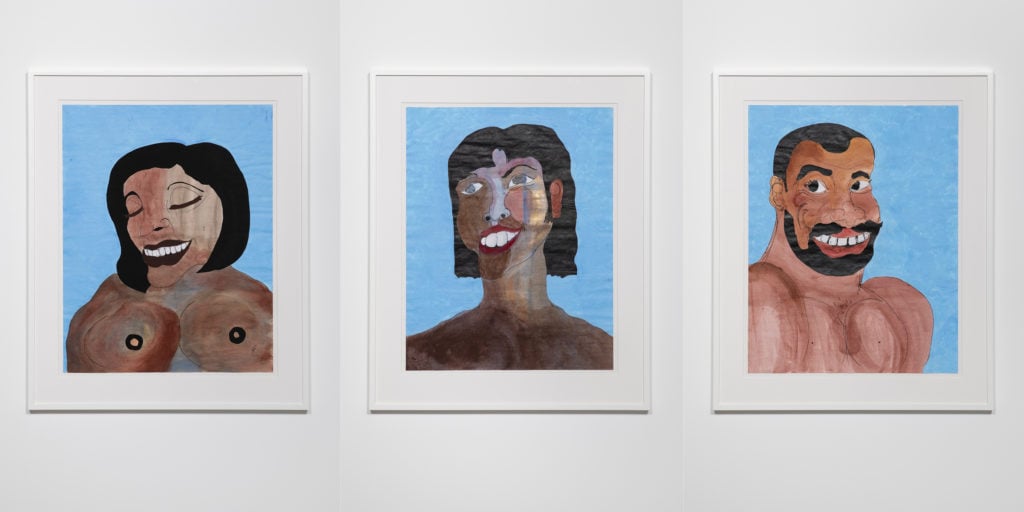
Tschabalala Self, Black Joy 8–Chocolate Lady with Pretty Teeth, Black Joy 9–Long Neck, Black Joy 10–Good Man (2019). Courtesy Pilar Corrias Gallery.
How do you guys weigh in on each other’s work? What have you learned about how you each like to receive feedback?
Mike: Tschabalala’s still learning about my work within the field of autism-spectrum disorders, because it’s a very complex thing. But because she has a very high understanding of art, she definitely understands how much I care about using art as a form of therapy. Both of our jobs are very demanding and require a lot of sensitivity. In the arts, people seem less friendly, and it’s this idea of “fake it till you make it.” And that’s fine, whatever, so I’m learning about all of that, and the intensity of all that.
Which must be so cutthroat, I’m sure.
Mike: Yeah, it’s really about having a wolf mentality sometimes. A survival mentality. You have to be like a shark in that sense, to have longevity.
Tschabalala: In terms of Mike, I’ll give him opinions about things and I’ll say, “This is a good idea,” or “Maybe it would be better if it was executed this way.” I think Mike is pretty receptive to my ideas, but he’s very much an independent thinker, too. He goes about things his own way, which I actually admire. I think I’m similar.
Mike: Oh, yeah. And I’m a social person, and she’s not really. I’ll say, “Tschaba, go say hi to that collector, or that curator!” And she’s like, “Hmmm…”
Tschabalala: We saw John Waters at the New Museum opening for Jordan Casteel and Peter Saul—I’m a huge fan of his, but I couldn’t manage to walk over to say hi.
Mike: Not a peep.
Tschabalala: Yeah. But Mike is great at parties, he’ll talk to everyone. He’ll do all the introductions and then I don’t really have to break the ice.
Mike: I think when you’re working with kids and adults who have unique needs you have to develop really strong communication skills. So I can go up to anyone, if I’m interested in that person, and have a conversation with them. And they can turn out to be cool people—you’d never know if you didn’t talk to them! Tschaba, you should try it, but then again you’ve made it this far without it.
What are you focusing on in 2020?
Tschabalala: I’m focusing mostly on my solo shows. I just opened up a show at the ICA Boston, which I’m very proud of. It’s a very mature overview of my practice thus far, and points to where my work is going. I am also currently working on my show opening at Eva Presenhuber Gallery in New York this May and preparing for my next institutional show at the Baltimore Museum of Art opening in the summer. So I’m focusing mainly on those projects, experimenting in my studio, and further developing my sculptural works. Those are my main objectives for 2020. I feel like it’s already zipping by.
Mike: I’m going to focus on curating the show in Hudson this fall and making sure it’s a success for all the artists involved. So yeah, just more exposure to art and learning about art as I pursue this next step. I want to keep learning about artists—their personalities and people in that world. Thank god I have the patience for that.
Tschabalala: Yeah, ’cause of me.
Mike: Yeah! And artists are like the customers—they’re always right, you know? You have to be like, “I’m not about to have a power struggle.” I’m the curator, for me it’s about working together and making their vision come to life. So that’s definitely my biggest goal for 2020.
What art-related activities do you guys like doing together?
Tschabalala: We like to see shows. We go to MASS MoCA a lot, because it’s close to Hudson…Art Omi. We’re going to go to Dia:Beacon and Storm King this spring. We haven’t gone together; we’ve actually never been to Dia:Beacon at all. And then friends’ openings.
Mike: And we watch a lot of films together, too.
Who are your favorite directors?
Tschabalala: My favorite is Abel Ferrara. I went to see his MoMA retrospective last year with my sister.
Mike: Mine is definitely early Spike Lee. The Mo’ Better Blues era, Do The Right Thing, Crooklyn. Clockers. Spike was super into art. I love John Singleton. And Quentin Tarantino. Once Upon A Time In Hollywood, I was like, “Wow, I wish this did happen.” Of course, there are many more directors that I like, but those are my top three.
You guys mentioned that you like traveling together. Where have you gone together recently?
Tschabalala: I think our best recent trip was to Joshua Tree. We actually went to Twentynine Palms, that’s where we stayed. And we went to the Yucca Valley. It was really cool.
Mike: We went to Pioneertown, where they shot a lot of old Westerns. Noah Purifoy’s outdoor art museum is definitely something you have to see.
Tschabalala: That’s actually why we went out there, to see that.
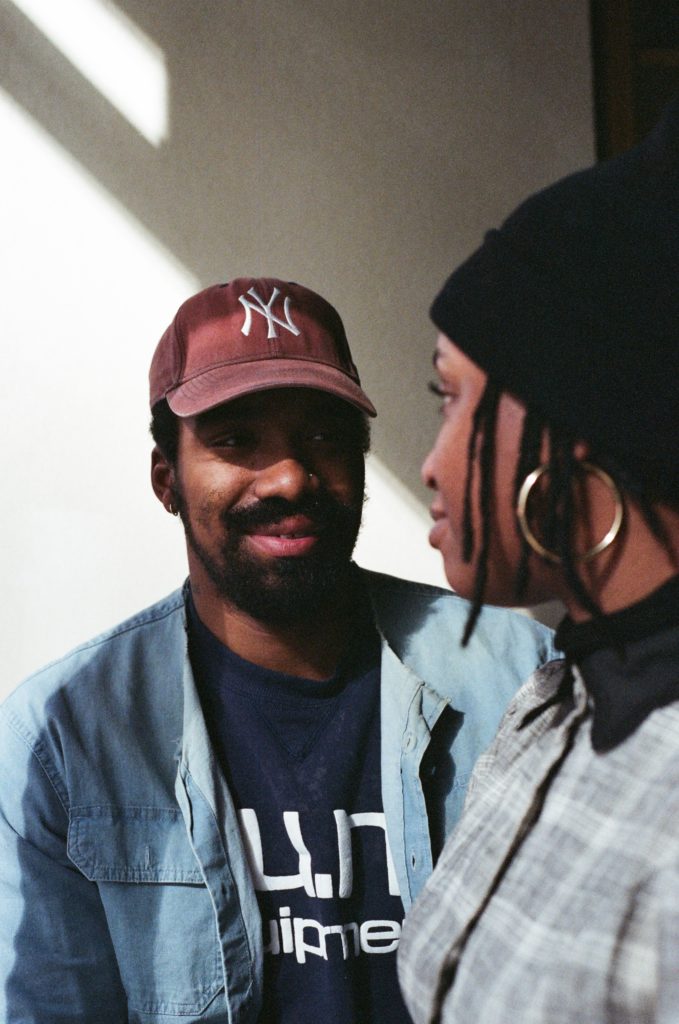
Mosby and Self. Photo courtesy Araba Ankuma.
Who are some of your favorite artists now? Do you ever think about jointly acquiring a work from a particular artist you both love?
Tschabalala: Together, we’d probably say Kara Walker, David Hammons, Mickalene Thomas, Derrick Adams…
Mike: Kerry James Marshall.
Tschabalala: Nina Chanel Abney. There are so many people. Warhol…maybe one of the celebrity portraits like Muhammad Ali. Faith Ringgold.
Mike: I love Barkley L. Hendricks. Oh my goodness, he’s so good. There’s so much beautiful work. And obviously Tschabalala Self, you know?
Tschabalala: But…I have my own work already.
You guys have a great dynamic.
Tschabalala: Yeah, it’s been a fun three years together. And we’re looking forward to many more.
Mike: Are you bored? Because I’m not.
Tschabalala: No! I think it’s like what Mike was saying earlier: We’re partners, but we’re also best friends. And that makes a big difference.